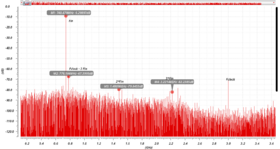Ans5671
Member level 2
I am simulating a DAC at 3GHz. The SFDR for different frequencies is as follows.
@ 100MHz = 67 dB
@ 700MHZ = 52 dB
@1.47GHz = 60 dB
I do not understand why the SFDR drops for middle frequencies. I have attached the graph for reference.
The Fclock - 3 * Fin amplitude is more than the 3 Fin. Why?
The spectrum is taken for 4096 clock cycles and 4096 * 128 point FFT of the transient output.
Thank you
@ 100MHz = 67 dB
@ 700MHZ = 52 dB
@1.47GHz = 60 dB
I do not understand why the SFDR drops for middle frequencies. I have attached the graph for reference.
The Fclock - 3 * Fin amplitude is more than the 3 Fin. Why?
The spectrum is taken for 4096 clock cycles and 4096 * 128 point FFT of the transient output.
Thank you
Attachments
Last edited:
